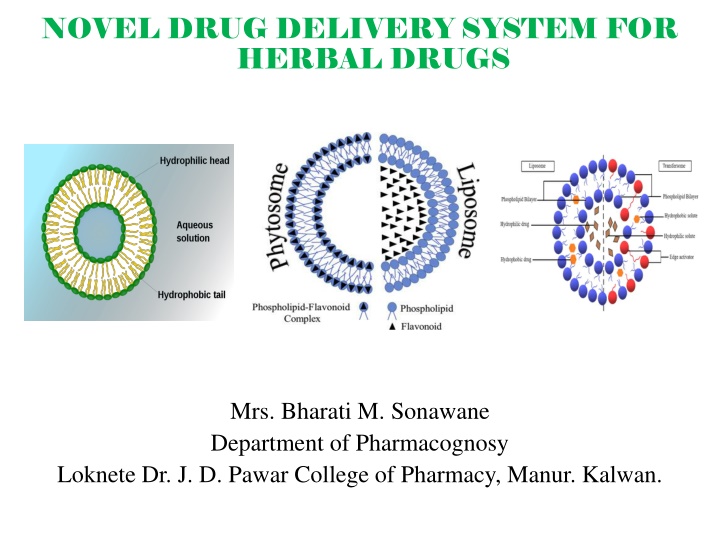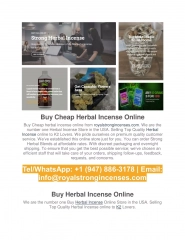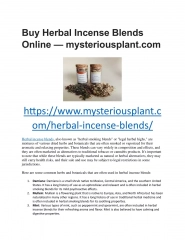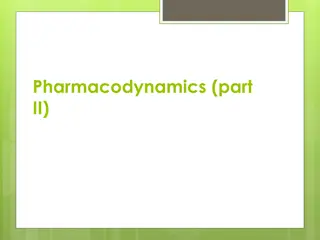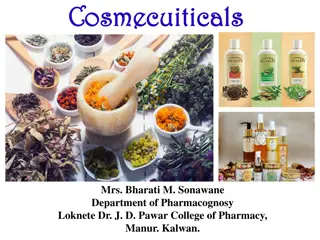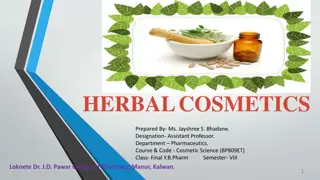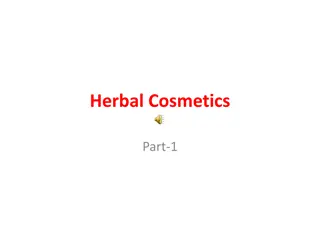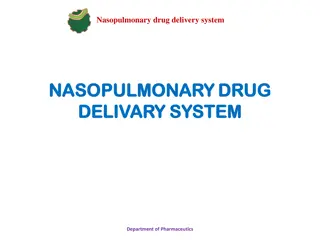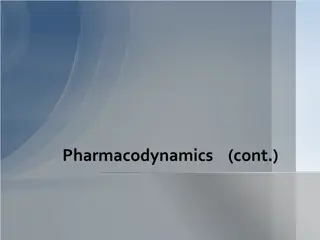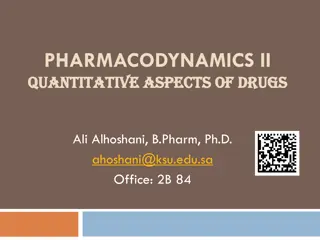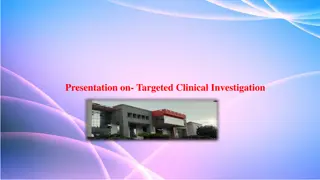Enhancing Herbal Drug Efficacy: Novel Delivery Systems
In the modern era, herbal drugs offer a safer alternative to synthetic molecules with fewer side effects. However, their efficacy can vary due to fluctuating concentrations of active constituents. Novel Drug Delivery Systems (NDDS) such as liposomes, niosomes, and microspheres play a crucial role in enhancing the stability, solubility, and targeted delivery of herbal drugs. Incorporating sophisticated technology can increase patient compliance and improve bioavailability, ensuring better therapeutic outcomes.
Download Presentation

Please find below an Image/Link to download the presentation.
The content on the website is provided AS IS for your information and personal use only. It may not be sold, licensed, or shared on other websites without obtaining consent from the author.If you encounter any issues during the download, it is possible that the publisher has removed the file from their server.
You are allowed to download the files provided on this website for personal or commercial use, subject to the condition that they are used lawfully. All files are the property of their respective owners.
The content on the website is provided AS IS for your information and personal use only. It may not be sold, licensed, or shared on other websites without obtaining consent from the author.
E N D
Presentation Transcript
NOVEL DRUG DELIVERY SYSTEM FOR HERBAL DRUGS Mrs. Bharati M. Sonawane Department of Pharmacognosy Loknete Dr. J. D. Pawar College of Pharmacy, Manur. Kalwan.
INTRODUCTION: In modern era we have the option to use them over the synthetic molecules because herbal drugs have lesser side effects. It is very clear that herbal drugs show their pharmacological action either due to specific constituent or due to blend of constituents. But the amount of constituents varies batch to batch due to ecological factors, tome of collection of plant. Pharmacological effect of the drug can be obtained only when its concentration ranges with in the therapeutic range. Any fluctuations above or below the therapeutic concentration lead to either toxic effects or no response. To overcome such cases and to enhance the efficacy of the herbal drug Novel Drug Delivery System (NDDS) play important role, which is a unique blend of various branches of science such as polymer technology, pharmaceutics, immunology, molecular biology, etc.
Various novel drug delivery systems such as liposomes, niosomes, microspheres and phytosomes have been reported for the delivery of herbal drugs. Incorporation of herbal drugs in the delivery system also aids to increase in solubility, enhanced stability, protection from toxicity, enhanced improved tissue macrophage delivery and protection from physical and chemical degradation. pharmacological distribution, activity, sustained
Novel drug delivery approaches: Novel approach of delivering herbal drugs will increase the efficacy and safety of herbal medicines along with the increased stability of the drug product. These techniques provide improved patient compliance, sustained release and targeted action of plant actives and extracts. Incorporation of sophisticated technology in delivering herbal or plant based products increased drug product stability, reduces pre systemic metabolism and toxic effects by accumulation of drugs to the non targeted areas and also increase patient compliance due to ease in drug administration and acceptability.
The complexity of active constituents makes it very challenging to the development of novel drug delivery system for herbal products. Hence, for enhancing the bioavailability of the drugs, there should be novel drug delivery systems and those can protect the drug from the other distractions of the body such acidic pH, reticuloendothelial system, metabolic process, etc. So, for better therapeutic outcome, it is important to incorporate herbal drugs or natural products in novel drug delivery systems .
Potentials of Novel Drug Delivery for Herbal drugs: Recently the use of herbal medicines has been increased all over the world due to their miraculous therapeutic effects and fewer adverse effects as compared to the modern medicines. However, delivery of herbal drugs also requires modifications with the purpose to achieve sustained release, to increase patient compliance etc. Previously herbal drugs could not attract scientists towards the development of novel drug delivery systems due to processing, standardising, extracting and identification difficulties.
But now days with the advancement in the technology, novel drug delivery systems opens the door towards the development of herbal drug delivery systems. Novel drug delivery technologies have gained the importance to achieve modified delivery of herbal drugs thereby increasing the therapeutic value as well as reducing toxicity. For last one decade many novel carriers such as liposomes, nanoparticles, phytosomes and implants have been reported for successful modified delivery of various herbal drugs e.g. curcumin, quercetin, silybin, ginkgo etc.
NOVEL DRUG DELIVERY SYSTEM FOR HERBAL DRUGS Mrs. Bharati M. Sonawane Department of Pharmacognosy Loknete Dr. J. D. Pawar College of Pharmacy, Manur. Kalwan.
LIPOSOMES: Liposomes are spherical, colloidal bilayered vesicular systems made up of biodegradable material i.e. Phospholipids. Phospholipids are the main structural units of these vesicles.
They are an amphipathic molecules having bipolarity in their structure. Due to this, upon hydration with aqueous media they adopt a characteristic spherical shape and construct an aqueous core with in them. The polar head of phospholipid orient itself towards the aqueous media while the hydrophobic tails constitutes the inner region of the membrane. From here we can see that there is both hydrophilic region as well as hydrophobic region within the liposomal vesicle. This property made them a versatile carrier system as they can entrap both hydrophilic as well as hydrophobic drug with in it. Lipophilic drug occupies the lipoidal domain with in the bilayered membrane while hydrophilic drug occupy the aqueous domain i.e. aqueous core.
Among various advantages associated with liposomes the noteworthy are: a) Solubility enhancement b) Enhancement of bioavailability c) Programmed targeting d) Prolongation of duration of action e) As they are lipoidal in constitution they enhance the tissue macrophagial uptake of the entrapped constituents. f) Stability associated problems can also be solved g) Absorption and disposition of the constituents can also be tailored.
Table 1: Herbal Formulations Based On Liposomal Drug Delivery System Sr. no. Plant / Constituents Application of Liposomal technology Biological activity Prolong action, permeation enhancement 1. Capsaicin Analgesic Long systemic residence time and high entrapment efficiency 2. Curcumin Anti cancer Garlicin Lungs Enhanced therapeutic outcomes 3. Nux vomica Anti neoplastic, anti inflammatory and analgesic Improved stability 4.
NOVEL DRUG DELIVERY SYSTEM FOR HERBAL DRUGS Mrs. Bharati M. Sonawane Department of Pharmacognosy Loknete Dr. J. D. Pawar College of Pharmacy, Manur. Kalwan.
PHYTOSOMES : They are bilayered system designed for the delivery of those drugs from which proper therapeutic outcomes can not be leached because of either of their high molecular weight or of their polar nature (e.g. flavonoids).
Phytosomes helps in overcoming these limitations in drug delivery so as to enhance the bioavailability of such chemical entity. Phytosome is ingredient & phospholipid. They involve binding of drug molecules to phospholipids (phosphatidyl choline) in a ratio (1:1 or 1:2) so as form lipid complexes. liposome generated both lipophilic as well as hydrophilic domains because of which they can entrap lipophilic as well as hydrophilic drugs. Work have been done on various herbal drug for making their phytosomes to make the therapy more effective such as, oxymatrin, silybin, embelin, etc. a complex natural active
Advantages: It is able to permeat the hydrophilic botanical extract to better absorbed in intestinal lumen. Increase absorption of active constituents. Dose size is small. It has appreciable drug entrapment, improvement in solubility and it can target the liver. It has good stability. Improves percutaneous absorption.
Table 2: Herbal Formulations Based on Phytosomal Drug Delivery Systems Sr. no. Plant / Constituents Application of Phytosomal technology Biological activity Curcumin Anti cancer and Anti oxidant Improved anti oxidant activity and bioavailability 1. Anti fertility and anti Bacterial Solubility enhancement 2. Embelin Ginsenosides Immuno modulator and neutraceutical 3. Absorption enhancement Anti cancer and anti inflammatory Prolong action and enhanced bioavailability 4. Naringenin
NOVEL DRUG DELIVERY SYSTEM FOR HERBAL DRUGS Mrs. Bharati M. Sonawane Department of Pharmacognosy Loknete Dr. J. D. Pawar College of Pharmacy, Manur. Kalwan.
Nanoparticles: Phytotherapeutics need a scientific approach to deliver the components in a sustained manner to increase patient compliance and avoid repeated administration. This can be achieved by designing novel drug delivery systems (NDDSs) for herbal constituents. NDDSs not administration to overcome non-compliance, but also help to increase the therapeutic value by reducing toxicity and increasing the bioavailability, and so on. Nanotechnology is a field of applied science and technology which aims to develop devices and dosage forms in the range of 1 to 1000 nm. The nanocarriers have been made of safe materials, including synthetic biodegradable polymers, lipids, and polysaccharides. only reduce the repeated
The effectiveness of many species of medicinal plants depends on the supply of active compounds. Most of the biologically active constituents of extracts, such as flavonoids, tannins, and terpenoids, are highly soluble in water, but have low absorption, because they are unable to cross the lipid membranes of the cells, have excessively high molecular size, or are poorly absorbed, resulting in loss of bioavailability and efficacy. NPs contain the drug embedded in the matrix or absorbed onto the surface. Microencapsulation nanoparticulate is an effective way used to protect drug or food ingredients against deterioration, interaction with other ingredients. of herbal extracts in volatile losses or premature
Advantages: This system delivers the herbal formulations directly to the site of action. Encapsulating drug within nanoparticles can improve solubility and pharmacokinetic of drugs. It reach to the choice of formulation, promote the drugs through the biological barrier and increase bioavailability. It can drug directly at the site of action without destroing surrounding environment.
Table 3: Herbal Formulations Based on Nanoparticles Chemical constituents Use Application Paclitaxel Anti-neoplastic Show sustained release Quercitrin Antioxidant Better therapeutic effect for intestinal anti-inflammatory action Silybin Anti- hepatotoxic activity Show sustained release and targeting system
NOVEL DRUG DELIVERY SYSTEM FOR HERBAL DRUGS Mrs. Bharati M. Sonawane Department of Pharmacognosy Loknete Dr. J. D. Pawar College of Pharmacy, Manur. Kalwan.
NOVEL VESICULAR HERBAL FORMULATIONS: Novel drug delivery attempts to either sustain drug action at a predetermined rate, or by maintaining a relatively constant, effective drug level in the body with concomitant minimization of undesirable side effects. The vesicular systems are highly ordered assemblies of one or several concentric lipid bilayer formed, when certain amphiphillic building blocks are confronted with water. The vesicular system such as liposomes, niosomes, sphingosomes, ethosomes, pharmacosomes are used to improve the therapeutic index of both existing and new drug molecules by encapsulating an active medicament inside vesicular structure in one such system. transferosomes and
NOVEL VESICULAR SYSTEM MODIFICATIONS TO LIPOSOMES: Niosomes- Rigorous conditions required for handling liposomes under cryogenic atmosphere have prompted the use of non-ionic surfactant in vesicular drug delivery system, in place of phospholipids. Thus, the new vesicular delivery system consisting of unilamellar or multilamellar vesicles called niosomes, was introduced. Niosomes can be changed or modified by the incorporation of other excipients like cholesterol, into the membrane and they can possess one or more lipid bilayers encapsulating an aqueous core.
TRANSFEROSOMES: Liposomal as well as niosomal systems, are not suitable for transdermal delivery, because of their poor skin permeability, breaking of vesicles, leakage of drug, aggregation, and fusion of vesicles.
Transdermal delivery has low as well as high molecular weight drugs. Each transferosome consists of at least one inner aqueous compartment, which is surrounded by a lipid bilayer with specially tailored properties, due to the incorporation of "edge activators" into the vesicular membrane. Transferosomes are vesicles composed by phospholipids as the main ingredient are (soya phosphatidylcholine, egg phosphatidylcholine, dipalmityl phosphatidylcholine, etc), 10-25% surfactants for providing flexibility (sodium cholate, tween 80, span-80), 3-10% alcohol as a solvent (ethanol, methanol) and hydrating medium consisting of saline phosphate buffer (pH 6.5-7).
ETHOSOMES: Ethosomes are novel carrier system used for delivery of drugs having low penetration through the biological membrane mainly by skin. Ethosomes are lipid vesicles containing phospholipids, alcohol (ethanol and isopropyl alcohol) in relatively high concentration and water, which are used mainly for transdermal delivery of drugs. Ethosomes have higher penetration rate through the skin as compared to liposomes hence these can be used widely in place of liposomes. SPHINGOSOMES PHARMACOSOMES
Thank You
